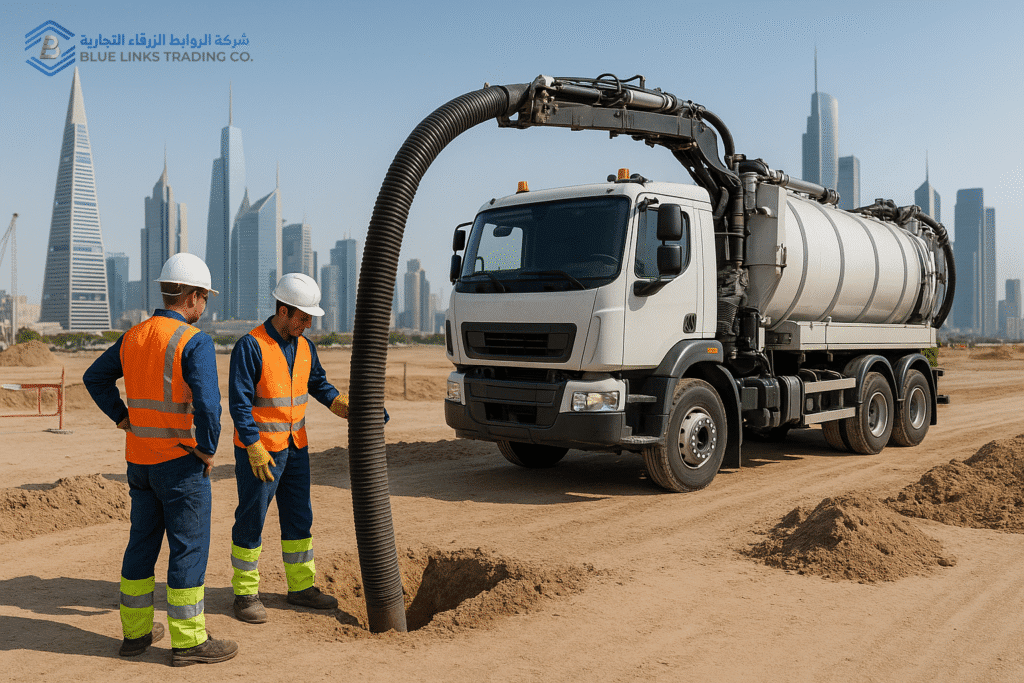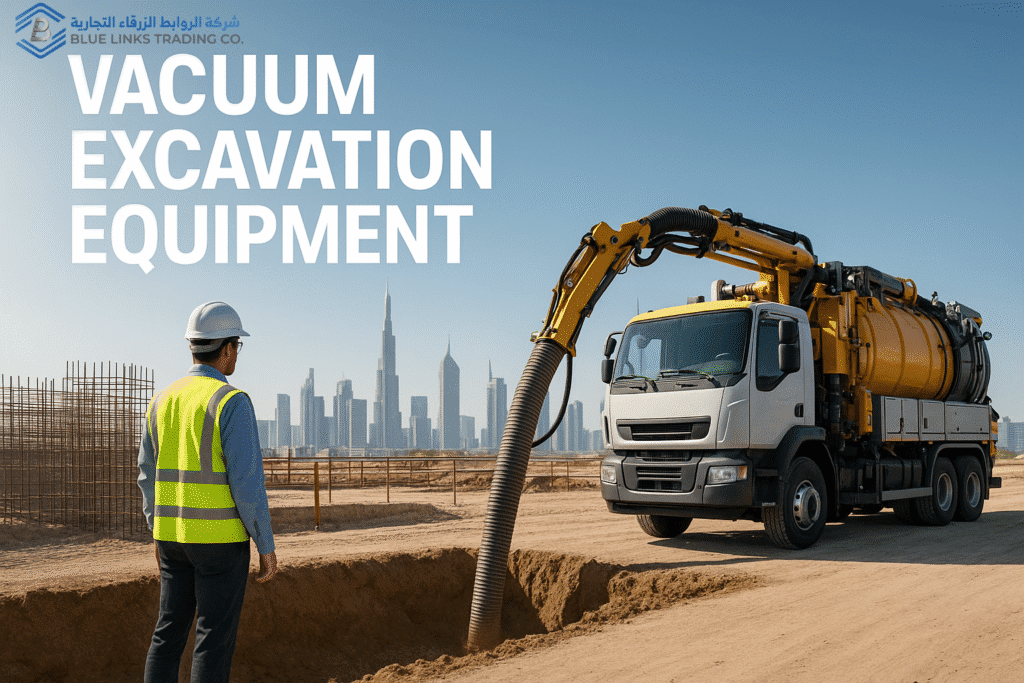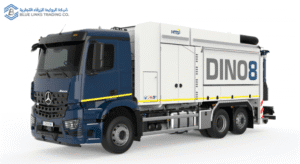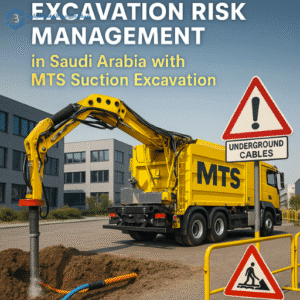Vacuum Excavation Equipment: The Safe and Precise Solution for Modern Infrastructure in Saudi Arabia and the Gulf

Introduction to Vacuum Excavation Equipment
In today’s construction and infrastructure projects, precision and safety are no longer optional—they are essential. Vacuum Excavation Equipment has quickly become one of the most reliable technologies for meeting these modern demands. Rather than using traditional heavy machinery that risks damaging underground infrastructure, vacuum excavation uses controlled air or water pressure to safely expose buried utilities.
This non-destructive method is especially important in places like Saudi Arabia and the Gulf, where massive infrastructure developments, smart city projects, and utility upgrades are taking place. Engineers and contractors face the constant challenge of digging around power cables, fiber optics, gas lines, and water pipelines without causing accidents or costly delays. Vacuum excavation equipment offers a smarter, safer, and faster way to handle these challenges.
By delivering precise excavation with minimal surface disruption, this technology is helping companies save time, reduce risks, and align with global standards of safety and sustainability.
How Vacuum Excavation Equipment Works
At its core, Vacuum Excavation Equipment relies on a simple but highly effective principle: loosen the soil with either air or water, then remove it using powerful suction into a secure storage tank. Unlike traditional methods that cut through the ground with sharp tools, this technique removes only the loose material, keeping surrounding structures intact.
There are two main approaches:

-
Air Vacuum Excavation (Dry Method)
-
Uses compressed air to break up the soil.
-
The loosened soil is then sucked into the vacuum system.
-
Advantage: the dry soil can be reused immediately for backfilling.
-
Best for projects in sandy or loose soils.
-
-
Hydro Vacuum Excavation (Wet Method)
-
Uses high-pressure water jets to cut and loosen the soil.
-
The resulting slurry is vacuumed into the holding tank.
-
Advantage: more powerful in clay or compacted soil.
-
Best for deeper or tougher excavation tasks.
-

Both methods are mounted on specialized trucks or trailers, making them mobile and adaptable to different job sites. The equipment is designed to operate in narrow urban streets, construction zones, and even industrial areas where traditional machinery cannot safely reach.
This combination of precision, flexibility, and mobility is what makes vacuum excavation a go-to solution for modern engineering projects.
For a more detailed breakdown of methods and technology, explore our MTS Suction Excavator Guide.
Types of Vacuum Excavation Equipment
Not all Vacuum Excavation Equipment is the same. Depending on the scale of the project and the type of soil, engineers can choose from different equipment designs to match their needs. The two most common categories are:
1. Truck-Mounted Units
-
Large, heavy-duty systems built on trucks.
-
Designed for major infrastructure projects such as highways, oil & gas fields, or smart city developments.
-
Can handle deeper excavation and larger soil volumes.
-
Often equipped with both air and hydro excavation options, giving contractors more flexibility.
-
Example: used in big urban projects in Riyadh and Jeddah where high-capacity performance is needed.
2. Portable or Trailer-Mounted Units
-
Smaller, more compact systems mounted on trailers or skid units.
-
Ideal for lighter tasks, utility repairs, or jobs in narrow and hard-to-reach locations.
-
Lower initial cost and easier to maneuver in urban streets.
-
Perfect for municipalities and maintenance crews working on water leaks, telecom faults, or electrical repairs.
By understanding the differences between these systems, companies can choose the equipment that offers the best balance of power, mobility, and cost-efficiency for their specific project.
Key Benefits of Vacuum Excavation Equipment

The rise of Vacuum Excavation Equipment isn’t just a trend—it’s a response to real challenges in construction and infrastructure projects. Here are the main benefits that make it the smarter choice compared to traditional digging:
1. Safety Around Underground Utilities
Traditional digging methods often risk damaging buried gas pipes, water mains, or fiber optic cables. Vacuum excavation minimizes this risk by removing soil gently and precisely, protecting both the infrastructure and the workers on-site.
2. Precision and Efficiency
By targeting only the soil that needs to be removed, vacuum excavation ensures accuracy. This precision translates into fewer delays, less rework, and smoother project timelines.
3. Cost Savings
Although the initial investment in vacuum excavation might be higher, the savings quickly outweigh the cost. Avoiding utility strikes means avoiding expensive repairs, compensation claims, and project shutdowns. Faster completion also means reduced labor expenses.
4. Environmentally Friendly Operation
Vacuum systems generate less dust, noise, and vibration compared to backhoes or jackhammers. This makes them ideal for projects in residential neighborhoods, environmentally sensitive zones, or crowded city centers where minimizing disruption is critical.
5. Flexibility Across Different Terrains
From sandy soils in coastal areas to compact clay in industrial zones, vacuum excavation equipment can handle a wide range of ground conditions. Its adaptability makes it a reliable solution for diverse projects across Saudi Arabia and the Gulf.
Applications in Real Projects
The true value of Vacuum Excavation Equipment becomes clear when we look at how it’s applied in everyday engineering and construction work. Its ability to deliver safe, precise, and efficient excavation makes it an essential tool across multiple industries:
1. Urban Infrastructure Development 🏙️
In busy cities like Riyadh or Jeddah, underground networks of water, power, and telecom cables are highly concentrated. Vacuum excavation allows engineers to dig safely without cutting through these critical utilities, while keeping traffic disruption to a minimum.
2. Oil & Gas Sector ⛽
In the Gulf’s oil refineries and pipeline corridors, safety is always the top priority. Vacuum excavation enables safe exposure of pipelines for inspection or maintenance without risking leaks, explosions, or shutdowns. This is especially valuable in Jubail Industrial City and similar hubs.
MTS, a German pioneer in suction excavation, highlights its proven use in oil & gas operations across Europe and the Middle East. Learn more at
MTS Suction Systems Germany.
3. Utility Maintenance and Repairs ⚡
For municipalities and service providers, vacuum excavation offers a clean and quick way to fix water leaks, gas lines, or telecom faults. Crews can create small, precise access points, finish the job, and restore the surface with minimal disruption.
4. Railway and Transport Projects 🚆
Railway maintenance often requires work in tight, sensitive areas. Vacuum excavators can efficiently remove soil or ballast around tracks without disturbing nearby infrastructure. This makes them suitable for GCC railway projects now under development.
5. Environmental and Sensitive Areas 🌍
When working near green zones, water reservoirs, or residential neighborhoods, minimizing vibration and noise is crucial. Vacuum excavation ensures low environmental impact and compliance with modern sustainability standards, aligning perfectly with Saudi Vision 2030.
Vacuum Excavation vs Traditional Methods
One of the best ways to understand the value of Vacuum Excavation Equipment is by comparing it with traditional digging methods like backhoes, trenchers, or manual shoveling.
1. Safety
-
Traditional Methods: Risk of striking underground pipes, cables, or gas lines is very high. A single mistake can lead to accidents, service interruptions, or costly repairs.
-
Vacuum Excavation: Removes soil without sharp tools, significantly reducing the chance of damaging hidden utilities.
2. Speed and Productivity
-
Traditional Methods: Digging can take days, especially in tight or complex urban areas.
-
Vacuum Excavation: Can often complete the same work in hours, even in confined spaces, because the process is precise and requires less rework.
3. Environmental Impact
-
Traditional Methods: Generate heavy noise, dust, and vibration, which can disturb residents and weaken surrounding structures.
-
Vacuum Excavation: Cleaner, quieter, and less disruptive—ideal for projects in residential or environmentally sensitive zones.
4. Cost Implications
-
Traditional Methods: Lower initial cost, but high risk of hidden expenses from utility damage, delays, and repairs.
-
Vacuum Excavation: Higher upfront investment, but reduces overall project costs by avoiding accidents, minimizing downtime, and ensuring faster completion.
Real-World Example
In a road maintenance project in Eastern Province, Saudi Arabia, traditional digging methods caused repeated delays due to the high density of underground utilities. Once vacuum excavation was introduced, the project was completed faster and without damaging any pipelines—saving both time and money for the contractor.
Challenges and Considerations
While Vacuum Excavation Equipment offers many clear advantages, it’s important for engineers and project managers to also understand its limitations. Recognizing these factors helps in planning effectively and avoiding unexpected issues.
1. Soil Conditions
-
Vacuum excavation works best in sandy, loose, or moderately compacted soils.
-
In rocky or extremely hard clay soils, hydro excavation is usually more effective but may create slurry that needs proper disposal.
2. Initial Investment Cost
-
The equipment requires a higher upfront cost compared to traditional digging tools.
-
However, this investment is usually recovered through savings in reduced damages, faster project timelines, and lower long-term expenses.
3. Training and Skilled Operators
-
Operating vacuum excavation equipment is not the same as driving a backhoe.
-
Teams need proper training to handle pressure controls, hoses, and safety procedures.
-
Without skilled operators, efficiency and safety benefits can be reduced.
4. Logistics and Site Access
-
Truck-mounted units require road access and space to operate effectively.
-
For very confined or remote areas, smaller portable units may be more practical but have lower capacity.
5. Disposal of Excavated Material
-
Dry vacuum excavation produces backfill-ready soil that can be reused immediately.
-
Contractors need a plan for safe and environmentally friendly disposal of this material.
Case Studies from Saudi Arabia and the GCC
The adoption of Vacuum Excavation Equipment in Saudi Arabia and the wider Gulf region is steadily growing, driven by the need for safer and more efficient solutions in major infrastructure projects. Here are a few real-world examples that highlight its impact:
1. Riyadh Urban Infrastructure
During utility upgrades in central Riyadh, traditional excavation methods posed a high risk of cutting through dense underground networks of telecom cables and water pipelines. Vacuum excavation was deployed, allowing contractors to dig narrow, precise holes with minimal disruption. The project was completed faster, with zero incidents of utility strikes.
2. Oil & Gas Operations in Jubail
In an onshore oil facility near Jubail Industrial City, excavation work faced delays due to the complexity of buried pipelines. The introduction of hydro vacuum excavation allowed teams to safely expose sensitive pipelines for inspection. This avoided shutdowns that would have cost millions in lost production.
3. Smart City Projects (NEOM)
Saudi Arabia’s Vision 2030 projects, such as NEOM, require modern, non-destructive construction methods. Vacuum excavation equipment is being considered as a standard tool for installing underground electrical grids and fiber optics. Its low environmental footprint and high precision make it suitable for futuristic, sustainable cities.
4. Municipal Maintenance in Dubai
In Dubai, utility maintenance teams adopted portable trailer-mounted vacuum excavators for emergency water leak repairs. Instead of digging large trenches, crews could quickly access the exact fault point. This minimized traffic disruption in busy residential areas and reduced repair time by over 40%.
The Future of Vacuum Excavation Equipment
As infrastructure continues to expand across Saudi Arabia and the Gulf, the demand for Vacuum Excavation Equipment will only increase. This technology is perfectly aligned with the region’s vision for smarter, safer, and more sustainable development.
1. Role in Smart Cities
Mega-projects like NEOM and The Red Sea Project require advanced construction techniques that protect underground networks. Vacuum excavation ensures safe installation of complex utility grids—electric, water, and fiber optics—without damaging surrounding infrastructure.
2. Integration with Vision 2030
Saudi Arabia’s Vision 2030 emphasizes sustainable growth and cutting-edge infrastructure. Non-destructive excavation methods like vacuum systems reduce environmental impact (noise, dust, vibrations) and improve worker safety, making them a natural fit for the Kingdom’s ambitious goals.
3. Technology Advancements
The next generation of vacuum excavation machines is expected to integrate with:
-
AI and Smart Sensors for precision digging.
-
GPS and Mapping Systems to detect underground utilities in real time.
-
Automation to reduce reliance on manual handling and improve efficiency.
4. Growing Global Adoption
While Europe has been a pioneer in vacuum excavation, the Middle East is quickly catching up. Contractors in Saudi Arabia, the UAE, and Qatar are increasingly adopting the technology as they realize its long-term benefits for safety, cost control, and sustainability.
Frequently Asked Questions About Vacuum Excavation
Conclusion and Call to Action
In a world where infrastructure projects are becoming larger and more complex, relying on outdated digging methods is no longer sustainable. Vacuum Excavation Equipment provides a safer, faster, and more precise alternative that protects underground utilities, reduces environmental impact, and saves money in the long run.
From busy city centers in Riyadh and Jeddah to sensitive oil fields in Jubail, this technology has already proven its value across Saudi Arabia and the Gulf. And with the rise of smart cities under Vision 2030, vacuum excavation is set to become a standard in modern construction practices.
For engineers, contractors, and decision-makers, the message is clear: adopting vacuum excavation today means fewer risks, more efficiency, and greater alignment with the future of sustainable infrastructure.

👉Ready to take your project to the next level?
Discover our full range of solutions on the MTS Suction Excavator Saudi Arabia







